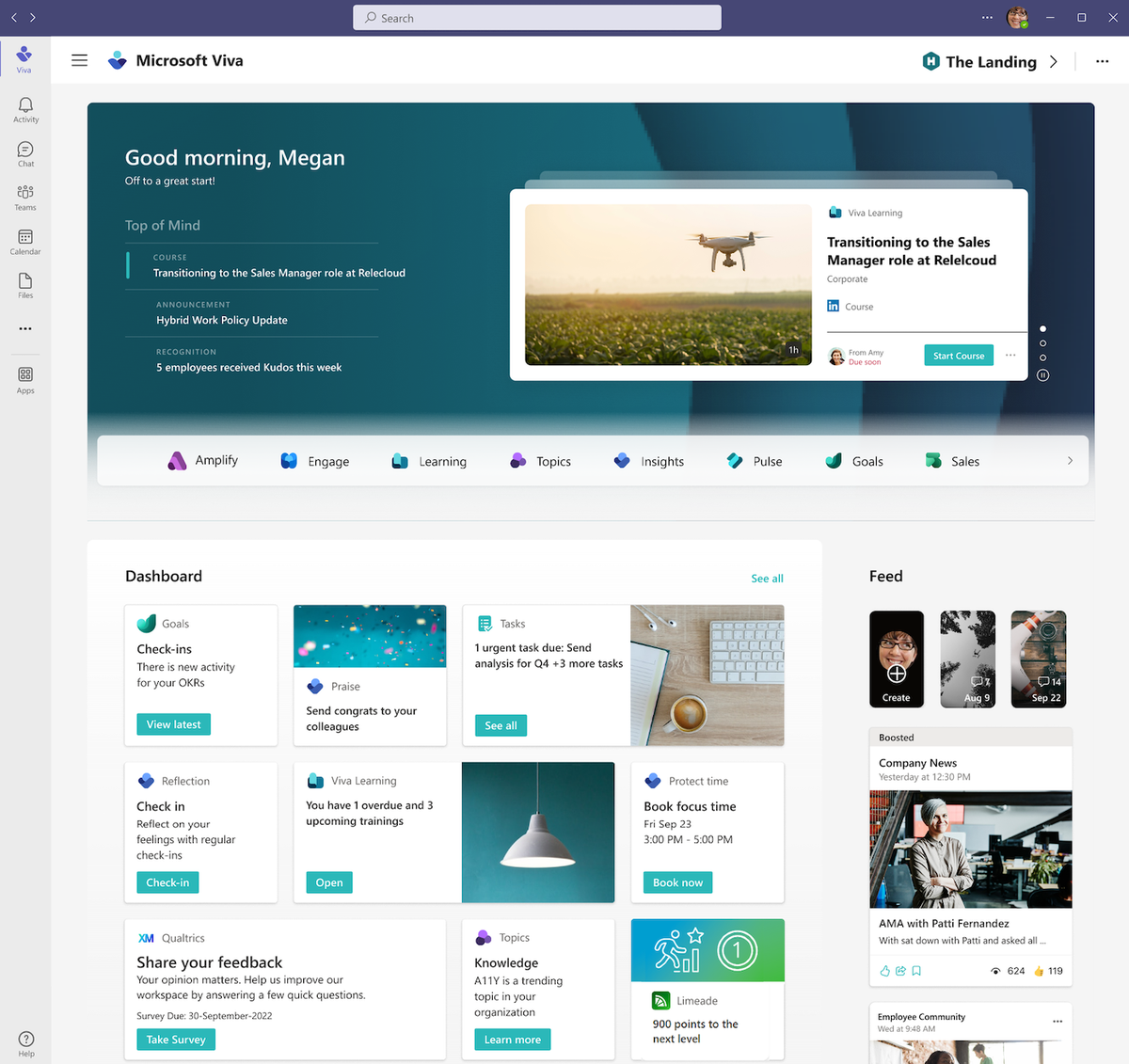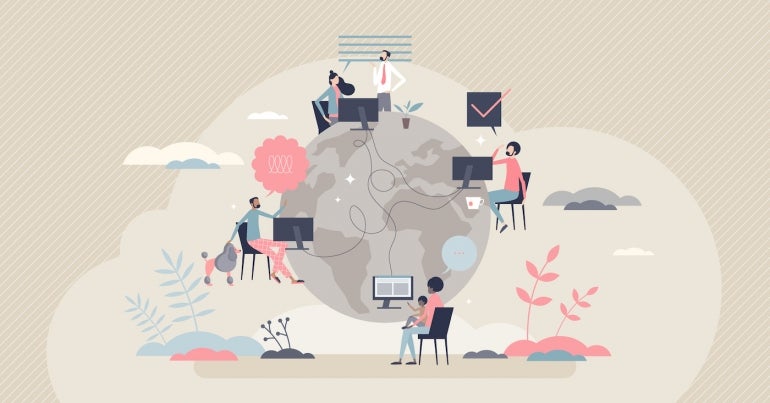
The latest Microsoft Work Trend Index shows that the stories you’ve heard about navigating the move to hybrid working aren’t just anecdotes. “People are working more than ever, and 87% of them feel they’re productive,” Sunita Khatri, senior director on Microsoft Viva told TechRepublic. But almost as many managers (85%) say they aren’t confident those employees really are being productive, and they resort to tracking trivial things like who uses their badge to get into the office, how long apps are open or even how many keystrokes employees make.
SEE: Hybrid work policy (TechRepublic Premium)
Hybrid work challenges include burnout and ‘productivity paranoia’
If they’re tracking the number of meetings, that’s still rocketing up. The number of meetings per week has gone up 153% for Microsoft Teams users since the start of the pandemic, being double booked for meetings is 46% more common in the last year, and while people are accepting only a few more meetings (3%), they’re declining or marking many more as tentative (up by 84% and 216%, respectively, in the last two years).
Employees want the flexibility of hybrid working but also help from their managers on prioritizing their work: Only 31% say they get that clearly enough – and only a quarter of managers get that help prioritising their own work from senior staff.
Knowing what their work priorities are and knowing that their feedback is listened to makes people much more likely to stay in a job. Prioritization means “helping them focus on the work that’s most important, the work that ladders up to what’s important for the company: what the company cares about but also what they care about for their career well-being,” Khatri said.
That’s especially important as about half of managers and employees alike say they’re burned out, so prioritizing has to include telling them what they can stop doing to free up time for what matters.
SEE: Employee objectives policy (TechRepublic Premium)
Meanwhile, managers crave the familiarity of an office where they could see people at their desks: about half say they struggle to trust hybrid employees are doing their best work and have less visibility into what they’re working on, resulting in a worrying mix of what Microsoft terms “productivity paranoia” by suspicious managers and “productivity theatre” by employees who feel they have to waste time proving they’re hard at work.
“Employers and employees are at a divide,” Khatri warned. “Employees have come to embrace flexible work and have moved away from that nine to five culture. At the same time, we’re also seeing leaders yearn for that 2019 office life and to add to the mix, we’re in one of the strangest recessions the world has ever seen.”
Inflation is up, budgets are down, some organizations have hiring freezes, but it can still be hard to hire talented people, she noted. “Even in this uncertain economic outlook, with the headwinds that are ahead of us, I do think that there are still people considering things like job hopping, the creator economy or side hustles as a means to figuring out, ‘where does my career well-being lie?’”
“Hybrid work has reached a critical point, and it’s putting pressure on the employee-employer relationship,” Khatri said.
How Microsoft Viva could help employees’ experiences
Organizations that really want staff back in the office have to do more than set a “back to your desk” policy.
“When people do come into the office and the office environment, they come in for each other,” Khatri pointed out. “Based on who’s going in, if I know someone else is going in, then maybe I’ll go in too. You have to give people a good reason, beyond policy, to go into the office.”
SEE: 250+ tips for telecommuting and managing remote workers (TechRepublic Premium)
Workers with managers who are open and supportive are more likely to go into the office to have meetings with them and slightly more likely to spend more days in the office overall.
“Retention is linked to [having] connections with colleagues, with [the company] vision, with leadership,” Khatri suggested.
Even so, remote and hybrid work is here to stay, so organizations need to get it right.
“We have to recognise that the office isn’t the only answer,” said Khatri. “But distributed work has led many people feeling isolated from organizational culture and values, and this is where leaders and companies have an opportunity to really connect people no matter where they work from.”
Improving the employee experience with Viva’s feedback and communications tools
Tools for improving the employee experience are what Viva is designed to deliver; that covers HR tools and benefits, training, development and employee well-being, and effective communications are key to most of that.
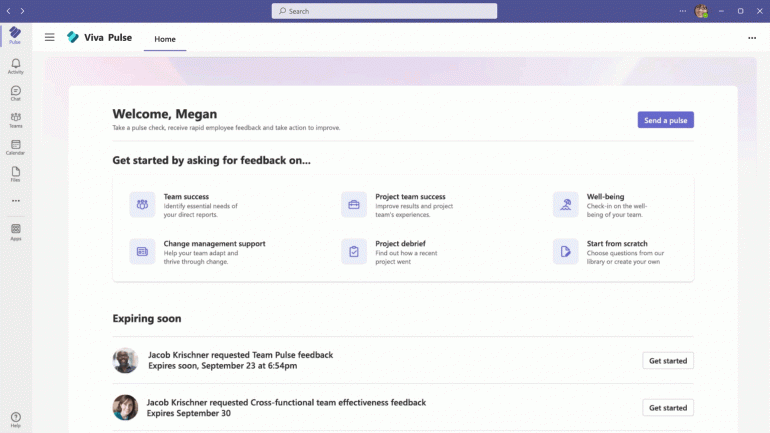
Microsoft’s Work Trend Index research shows that half of companies rarely or never collect employees’ feedback about what it’s like to work for them. Viva Pulse is a new tool for collecting and managing feedback.
Khatri described Viva Pulse as “a new way for managers to be able to seek regular confidential feedback from their teams, on their experience on what’s working, what’s not working, and most importantly, create trust with their teams by bringing those anonymized trends and suggestions into team conversations.”
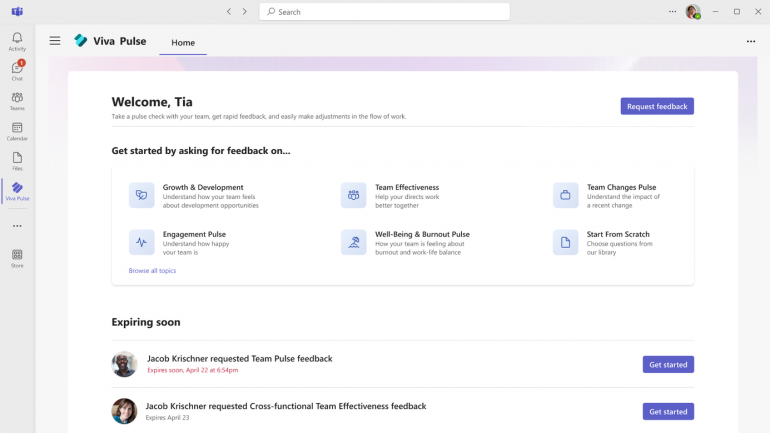
This isn’t the kind of impromptu poll you would use in a Microsoft Teams chat to decide whether the next team event should be a party or volunteering for a charity. Templates guide managers to ask about the impact of changes at work, how well a team works together, and how happy or burned out people are feeling, without leading questions that can pressure people into saying what they think their boss wants to hear.
Feedback is anonymized, and rather than individual replies, managers can look at trends and patterns. Managers even get homework with suggestions for training they can take to manage better as well as suggested actions to take with their team.
Pulse is designed to work alongside the new Viva Goals module that helps connect what employees are told to work on with what the company says its goals are each quarter, so it’s clear what priorities should be.
Viva Goals now integrates with Azure DevOps, Power BI and Microsoft Project and Planner for tracking work items and results that feed into OKRs, so managers can see what message they’re sending to staff and how that’s affecting the work they do as well as how they feel about their work. This gives managers a way to get away from productivity theatre and paranoia to measuring what they actually care about.
Viva’s tools improve work communications and culture
Microsoft is adding even more ways for leaders and managers to communicate with employees, with the new Viva Amplify tool for sharing official company communications from executives and HR, which includes tools to help communications teams write and publish as well as metrics for tracking how widely those are seen. Khatri calls it a back-end service for employee communications teams.
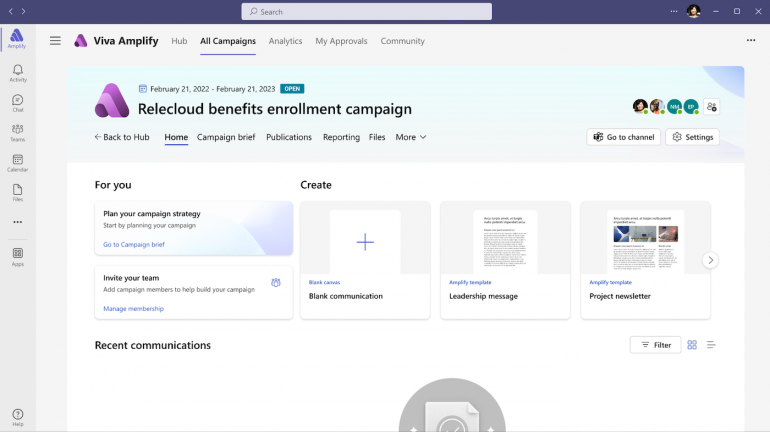
“Imagine you’re onboarding 20,000 employees a quarter and using Viva Amplify to send communications to those 20,000 employees in a centralized way,” said Khatri. “So, now you have one destination that you can go to as an employee communications team, whether you’re HR or IT or workplace communications: You can build out that campaign, and you can distribute that campaign directly to those new hires in a much more meaningful way.
“As a communications team, you only want to build that message once, and you want to be able to have that message appear consistently in a streamlined way across multiple endpoints, whether it’s on your machine when you log in for the very first time on your first day or whether it’s in your inbox or a community conversation that’s happening around the new hire resource group.”
Viva adapts to the communication preferences of all employees
The places where these communications are published might be something as free form as Yammer or Viva Engage, but senior leaders may need a more structured way to communicate.
“Viva Engage builds community and allows you to spark meaningful conversations, enables employees to be able to connect peer-to-peer, build their networks and create their following with social tools,” Khatri explained.
The new Leadership Corner in Viva Engage is a tool for executives to interact with employees and hold “ask me anything” events.
“Leaders can schedule those events and be able to understand what’s working, what questions are being posted out there and track the engagement of those questions,” Khatri added.
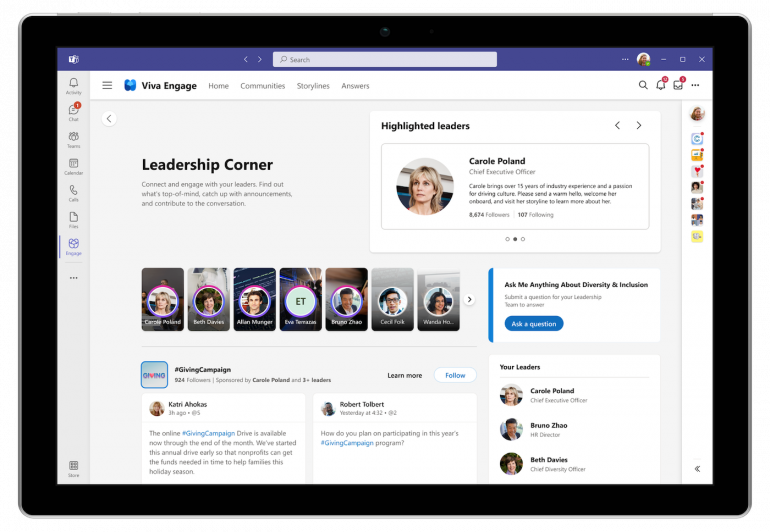
With the storytelling features announced recently and the way Viva Topics and Viva Connections bring Yammer into Teams, it might look like a confusing number of different ways to communicate inside the organization, but these are different tools for different kinds of communication, Khatri explained.
Viva offers modules for four types of experiences
Rather than thinking about the tools in Viva as separate modules just because you can pick and choose which ones you buy, she suggested looking at what you want to use Viva for and how it fits into employee journeys, like onboarding new employees.
SEE: Checklist: Onboarding and offboarding IT staff (TechRepublic Premium)
“Viva provides an experience across four areas: connection, insight, purpose and growth,” Khatri said. “Connection combines together in a cohesive experience across Viva Connections, Viva Engage and Viva Amplify to build and streamline how employees connect with company culture, but also how they’re informed and engaged as they move forward.”
“Insight is around providing organizations with the right workplace analytics and feedback capabilities,” added Khatri — that’s Viva Insights and the new Pulse tool. “That combined solution allows employees, managers, leaders to get the insights that they need, right in the flow of work and be able to protect their well-being and take action and balance well-being with productivity.”
Viva Goals is currently the only tool that Khatri classes under purpose (Viva Sales is the first of what might be several Viva tools for a specific kind of job rather than the broader idea of purpose). Growth is about training, expertise and knowledge management, and that includes Viva Learning; Viva Topics; and the new Answers in the Microsoft Viva tool, which managers can think of as their own company version of Quora.
“Think of it as moving away from traditional search in a company,” Khatri suggested. “Search is obviously a very big pain point. You want to know the answer to something, and you have to hunt a million different places to find it.”
Viva’s tools help keep employees informed and moving forward all in one dashboard
Answers builds on Viva Topics, and the Q&A features in Yammer that find answers that have been marked as helpful.
“We use AI and natural language processing to match employee questions to experts across the organization to help put collective knowledge at work,” Khatri noted.
If there’s a relevant topic card you’ll see that, along with details of who is an expert in that area. If there are questions that haven’t been answered, those experts will get a request to help out, but next time the same question is asked, their answers will appear automatically.
Someone starting work will use all those different experiences, starting with connection and purpose.
“Think of all the things that you need as you get up to speed,” said Khatri. “You want to engage with what the company is all about; the culture, the mission. You want to understand what is my role and what’s behind what my team is working on, but also how does my job then contribute to the overall mission and the goals of the team. You want to be able to understand what others are working on as well.
“What are the different communities? What are the different employee resource groups that I can connect with as I get up to speed in my job?”
“Then you can think of the growth areas like Viva Learning as a way for managers to create pathways for those new hires to be able to understand what are some of the things that I need to learn specifically for this particular job to be more efficient in the role that I’m joining,” said Khatri.
With so many new tools, Viva Connections, which helps employees find company resources, is getting a new design to help make that clearer.
“It will not only allow employees to engage in news, events, conversations directly from things like Yammer or from Viva Engage but also be a destination where they can access all of their to do’s from all the different Viva apps and services, all in one experience,” Khatri explained.
A dashboard also brings third-party tools into this new Home view.
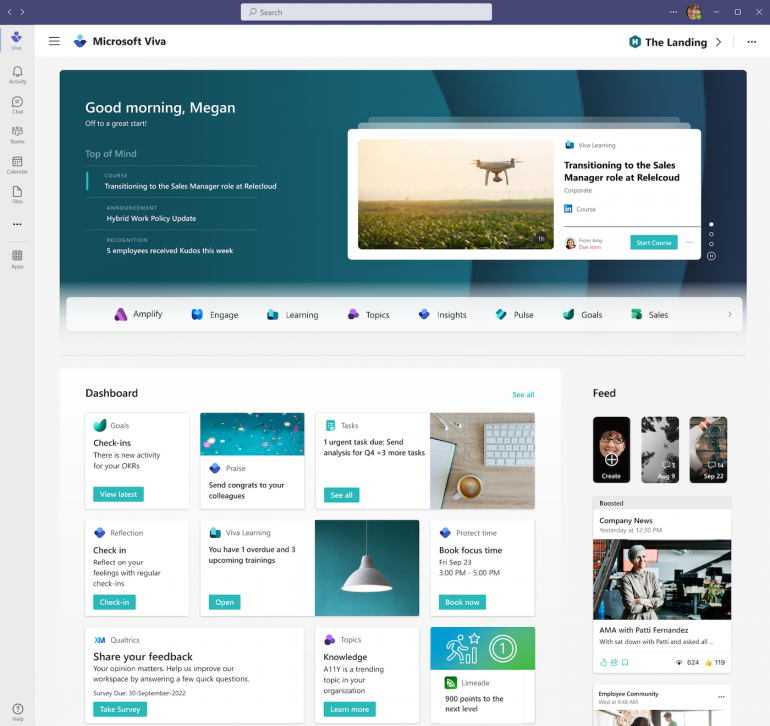
Organizations that only pay for Viva Learning and Viva Insights but don’t have Viva Engage to bring it all together can use the new common navigation to jump between them, to make sure the tools that are supposed to improve their productivity aren’t getting in the way.
